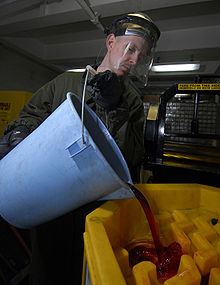
Hydraulic fluid(s), also called hydraulic liquid(s), are the medium by which power is transferred in hydraulic machinery. Common hydraulic fluids are based on mineral oil or water. Examples of equipment that might use hydraulic fluids include excavators and backhoes, hydraulic brakes, power steering systems, transmissions, garbage trucks, aircraft flight control systems, lifts, and industrial machinery.
Hydraulic systems like the ones mentioned above will work most efficiently if the hydraulic fluid used has zero compressibility.
The primary function of a hydraulic fluid is to convey power. In use, however, there are other important functions of hydraulic fluid such as protection of the hydraulic machine components. The table below lists the major functions of a hydraulic fluid and the properties of a fluid that affect its ability to perform that function:
The original hydraulics fluid, dating back to the time of ancient Egypt, was water. Beginning in the 1920s, mineral oil began to be used more than water as a base stock due to its inherent lubrication properties and ability to be used at temperatures above the boiling point of water. Today most hydraulic fluids are based on mineral oil base stocks.